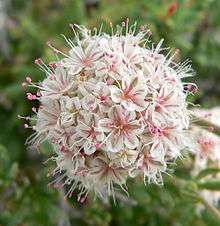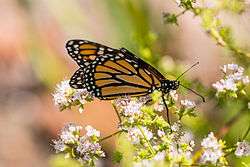Eriogonum fasciculatum
Eriogonum fasciculatum is a species of wild buckwheat known by the common names California buckwheat and eastern Mojave buckwheat.
| Eriogonum fasciculatum | |
|---|---|
 | |
| Scientific classification | |
| Kingdom: | Plantae |
| Clade: | Tracheophytes |
| Clade: | Angiosperms |
| Clade: | Eudicots |
| Order: | Caryophyllales |
| Family: | Polygonaceae |
| Genus: | Eriogonum |
| Species: | E. fasciculatum |
| Binomial name | |
| Eriogonum fasciculatum | |
.jpg)
%3B_Hidden_Valley_Trail_-_12525828333.jpg)
Distribution
This common shrub is native to the Southwestern United States, California, and northwestern Mexico. It is found from the coasts of California and Baja California; eastwards through the Southern California Coast Ranges, Transverse Ranges, and Peninsular Ranges; and further east into the Mojave Desert and Great Basin.
It grows on slopes and dry washes in diverse habitats, including chaparral, coastal sage scrub, grasslands, sagebrush scrub, pinyon-juniper woodland, and creosote bush scrub.
Description
Eriogonum fasciculatum is variable in appearance, forming a patchy, compact bramble or a spreading bush approaching 2 metres (6.6 ft) in height and 3 metres (9.8 ft) across. The leaves grow in clusters at nodes along the branches and are leathery, woolly on the undersides, and rolled under along the edges.
Flowers appear in dense, frilly clusters which may be anywhere from a few millimeters to 15 centimeters wide. Each individual flower is pink and white and only a few millimeters across.[1]
Varieties
There are a number of distinct varieties, they include:
- Eriogonum fasciculatum var. emphereium—endemic to western El Vizcaíno Biosphere Reserve[2]
- Eriogonum fasciculatum var. fasciculatum [3]
- Eriogonum fasciculatum var. flavoviride—eastern Mojave buckwheat.[4]
- Eriogonum fasciculatum var. foliolosum—red topped buckwheat.[5]
- Eriogonum fasciculatum var. polifolium [6]
Uses
Humans
California buckwheat has been used as a food crop and medicinal plant by various Native American tribes.[7] Some tribes would make tea from the leaves, stems, and roots; whilst other tribes used the seeds to be consumed raw or used in porridges and baked items.[8]
The Tongva, who call the plant wilakal, gather the leaves before flowering to make into a strong thick tea and grind the dried roots to use for headaches and stomach problems.[9]
This widespread species was used extensively as a traditional medicinal plant by Native Americans for a variety of ailments, including the treatment of headache, diarrhea, and wounds.[10] The Zuni people use a poultice of powdered root and apply it to cuts and arrow or bullet wounds. A decoction of the root is taken after parturition to heal lacerations. This same decoction is also taken for hoarseness and colds involving the throat.[11]
Wildlife
This species is the most important native source of honey in California, particularly attractive to numerous species of native bees and other pollinators, and is a good source of nectar over many months in dryer areas.[12] It also attracts introduced honey bees (Apis mellifera).
California buckwheats are nectar food plants for several butterflies, notably the Bernardino dotted-blue (Euphilotes bernardino), lupine blue (Icaricia lupini), Mormon metalmark (Apodemia mormo), and Behr's metalmark (Apodemia virgulti).[12] Probably the butterfly most commonly seen with the species is the nut-brown hairstreak (Satyrium saepium), which frequents plants in full flower.[12] It is a larval host for the Acmon blue, blue copper, Electra buckmoth, Gorgon copper, lupine blue, and western green hairstreak.[13]

Cultivation
Eriogonum fasciculatum is cultivated as an ornamental plant, for planting in native plant, drought tolerant, and wildlife gardens, and for larger designed natural landscaping and habitat restoration projects.
References
- "E. fasciculatum (Benth.) Torr. & A. Gray". Jepson Manual. University of California. 1993. Retrieved 2009-04-12.
- Tropicos.org: Eriogonum fasciculatum var. emphereium
- Calflora: Eriogonum fasciculatum var. fasciculatum
- Calflora: Eriogonum fasciculatum var. flavoviride
- Calflora: Eriogonum fasciculatum var. foliolosum
- Calflora: Eriogonum fasciculatum var. polifolium
- https://www.cabrillo.edu/~crsmith/OhloneMed.html
- https://arboretum.ucsc.edu/pdfs/ethnobotany-webversion.pdf
- "Wilakal".
- University of Michigan at Dearborn: Native American Ethnobotany of Eriogonum fasciculatum
- Stevenson, Matilda Coxe 1915 Ethnobotany of the Zuni Indians. SI-BAE Annual Report #30 (p. 49)
- Flora of North America: Eriogonum fasciculatum
- The Xerces Society (2016), Gardening for Butterflies: How You Can Attract and Protect Beautiful, Beneficial Insects, Timber Press.